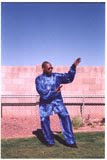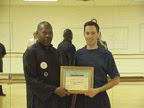Our summer RAD class has been great because the students are focused, motivated, and fully engaged. Learning Chin Na is a wonderful experience opening the mind to the wisdom of Mathematics, Science, and Philosophy. Of course I should mention that the experience of learning and practicing Chin Na is also fun. We discussed some of the philosophical aspect of this art in my last Post. The life lessons embedded in the practice and philosophical understanding of Chin Na include harmonizing, blending, yielding, asserting, self-restraint, mercy, empathy, compassion, balance, foundation, direction, coordination, and clarity of purpose. All of these lessons apply not only to the proper execution of Chin Na techniques but also to the Path that the wise man (or woman) will follow in his or her everyday life. Mathematics, Science, and Philosophy are the master tools of the Warrior-Priest for they are the means by which he or she removes uncertainty and establishes definitive purpose.
Mathematics
Mathematics, the abstract science of number, quantity, and space is an important language for understanding the nature of our reality. Everything in creation seems to have mathematical characteristics associated with its existence and functioning. Just as Astronomical mathematics focuses on understanding and explaining aspects of the physical universe, and applied mathematics focuses on the functional use of mathematics in the practical fields of research and development, so to the martial arts has a mathematics-based focus on the development and application of techniques. This is especially true in the art of Chin Na.
Efficient – Achieving maximum productivity with minimum wasted effort or expenditure of energy or resources.
- It should not take more to two (2) – three (3) steps (moves) to gain control over your opponent’s movements
- It should not take more one half (1/2) to two thirds (2/3) of your power to execute your technique
Relative weight, height, upper-lower body ratio, arms and legs length are all mathematical assessments that fortunately you mind is able to make without you having to actually do the math. Likewise, how hard to strike, how deep to press, how much to twist are also subconsciously processed calculations that your mind makes especially after proper training. Efficiency is the underlying mathematical principle being expressed in Chin Na. The efficient use of Qi, physical strength, and movement. These three coalesced into dynamic power when they are properly applied based upon the Sciences of Anatomy and Physiology. Anatomy is the branch of science concerned with the bodily structure of organisms. Physiology is focused on how the body of organisms function.
Rhythm – A strong, regular, repeated pattern of movement or sound. Actually for us it is both – movement of the body and the sound of the breath. Rhythm is a regularly recurring sequence of events, actions, or processes. Rhythm is fundamentally mathematical in nature.
The effective application of Chin Na requires a mastered rhythm that allows the practitioner to move with perfect grace and timing – creating a symbiotic relationship between himself or herself and the opponent(s).
- It should not take more than three (3) seconds to gain initial control over your opponent – one thousand and one - one thousand and two - one thousand and three. If initial control is not established in three (3) seconds your technique is likely to fail allowing your opponent to escape and counterattack.
Science
Chin Na is the mathematical application of self-defense techniques based upon the mechanics of the human body – its anatomy and physiology.
- The fingers are not designed to bend backwards against the back of the hand and only the fingertips can touch the palms
- The finger joints are not designed to bend backwards or sideways not to be rotated clockwise or counterclockwise
- The fingertips are hosts to the beginning and end points of various meridians and are not designed to be squeezed or pressed
- The hands are not designed to lie flat against the wrists not to be bent sideways
- The elbows are not designed to bend backwards
- The shoulders are not designed to bend backwards horizontal to the shoulders
- If the elbows are pressed the shoulders must follow
- If the head is controlled the body will follow
- The muscles can seize and be seized
- The qi pathways is vulnerable where bone, muscles, ligaments, tendons, nerves, and blood vessels cross paths
- If the feet cannot follow the head the body will be in confusion (Sticky Dragon)
- The body needs both blood and qi – stop the flow of one and the other will fail
- Make your opponent’s body move in ways that your body rebels against
Live Wu-Te
Seifu Sharif
Support the Wu-Te Performance Troupe
Preview Wu-Te: A Guide To Parents - Why Train Your Children in
the Traditional Martial and Healing Arts?
Preview Wu-Te: A Guide To Parents - Why Train Your Children in
the Traditional Martial and Healing Arts?
A good Chin Na Reference Book: Shaolin Chin Na: The Seizing Art of Kung Fu, Yang Jwing-Ming, Unique Publications, 1982, ISBN: 0-86568-012-4


